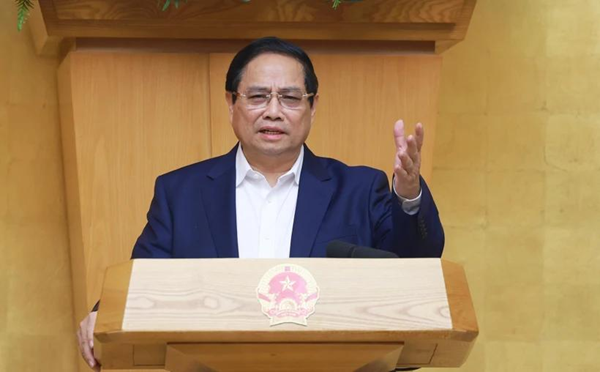<i id='EFBDC88726'><strike id='EFBDC88726'><tt id='EFBDC88726'><ins date-time="5e2a25"></ins><small dir="b47582"></small><sup lang="b42809"></sup><pre date-time="35d219" id='EFBDC88726'></pre></tt></strike></i>
 |
| Prime Minister Phạm Minh Chính speaks at the regular Cabinet meeting in Hà Nội on April 6. VNA/VNS Photo |
HÀ NỘI — Prime Minister Phạm Minh Chính on April 6 chaired a regular Cabinet meeting and a teleconference between the Government and localities to assess the socio-economic situation in March and the first quarter of this year, and outline key tasks for April and the time ahead.
In his opening remarks, the leader pointed to the complex and unpredictable global developments, especially with the US announcing massive reciprocal tariffs, which also include Việt Nam, along with escalating trade tensions that may disrupt production and supply chains.
He said right from the beginning of this year, Việt Nam has taken all necessary measures to balance trade with the US, most notably the recent phone talks between Party General Secretary Tô Lâm and US President Donald Trump to discuss bilateral relations, especially in economy and trade.
Vietnamese authorities have also worked on cutting import tariffs and held meetings with US associations, businesses, and scientists, added.
The PM emphasised efforts in expanding export markets, diversifying products, markets, and supply chains, and utilising the 17 Free Trade Agreements (FTAs) and other cooperation frameworks in which Việt Nam is member.
Right after US President Trump’s tariff announcement, permanent Cabinet members convened a meeting to assess the situation and put forth solutions, he said, adding a rapid response task force has been established for this issue.
According to the leader, Deputy PM Hồ Đức Phớc will travel to the US to engage in discussions with the US side.
On April 5 afternoon, permanent Cabinet members and representatives of various ministries and agencies also met to look into economic and trade cooperation with the US, and the implementation of the messages from Party General Secretary Lâm and President Trump during their phone call.
“This should be seen as an opportunity for Việt Nam to restructure its economy, foster rapid and sustainable development based on science, technology, innovation, and digital transformation, and restructure and diversify products, markets, and supply chains,” he said, referring to the tax issue.
Chính set forth main tasks for the time ahead, such as striving for a growth target of at least 8 per cent based on the new scenario, towards double-digit growth in the coming time; continuing with the restructuring of the political system and local administration; preparing and organising Party congresses at all levels leading up to the 14th National Party Congress; implementing the Politburo’s Resolution 57 on breakthroughs in science-technology development, innovation, and national digital transformation, and Resolution 59 on international integration in the new context; and preparing and organising major national holidays.
Regarding socio-economic performance in the first quarter, the leader emphasised the growth rate of 6.93 per cent, with achievements seen in industry, agriculture, and services, especially agriculture.
However, there remained limitations and difficulties, such as pressure on exchange rates, rising inflation; slow recovery in purchasing power; issues in the real estate market; a lower rate of public investment capital disbursement; and numerous risks and challenges, especially after the US announced the new tariffs.
Against the backdrop, the PM said it is a must to clearly identify responsibility of each ministry, sector, and locality, to implement mechanisms and policies in order to resolve institutional obstacles, to boost public investment that would contribute 2 per cent to growth, and to foster traditional growth drivers like investment, consumption, and exports. — VNS
评论专区